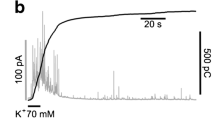Abstract
The influence of changes in intra- and extracellular pH (pHi and pHe, respectively) on the cytosolic, free calcium concentration ([Ca2+]i) of neocortical neurons was studied by microspectrofluorometric techniques and the fluorophore fura-2. When, at constant pHe, pHi was lowered with the NH4Cl prepulse technique, or by a transient increase in CO2 tension, [Ca2+]i invariably increased, the magnitude of the rise being proportional to ΔpHi. Since similar results were obtained in Ca2+-free solutions, the results suggest that the rise in [Ca2+]i was due to calcium release from intracellular stores. The initial alkaline transient during NH4Cl exposure was associated with a rise in [Ca2+]i. However, this rise seemed to reflect influx of Ca2+ from the external solution. Thus, in Ca2+-free solution NH4Cl exposure led to a decrease in [Ca2+]i. This result and others suggest that, at constant pHe, intracellular alkalosis reduces [Ca2+]i, probably by enhancing sequestration of calcium. When cells were exposed to a CO2 transient at reduced pHe, Ca2+ rose initially but then fell, often below basal values. Similar results were obtained when extracellular HCO -3 concentration was reduced at constant CO2 tension. Unexpectedly, such results were obtained only in Ca2+-containing solutions. In Ca2+-free solutions, acidosis always raised [Ca2+]i. It is suggested that a lowering of pHe stimulates extrusion of Ca2+ by ATP-driven Ca2+/2H+ antiport.
Similar content being viewed by others
References
Abercrombie RF, Hart CE (1986) Calcium and proton buffering and diffusion in isolated cytoplasm from Myxicola axons. Am J Physiol 250:C391-C405
Alvarez-Leefmans FJ, Rink TJ, Tsien RY (1981) Free calcium ions in neurons of Helix aspersa measured with ion selective microelectrodes. J Physiol (Lond) 315:531–548
Benham C, Evans M, McBain C (1992) Ca2+ efflux mechanisms following depolarisation evoked calcium transients in cultured rat sensory neurons. J Physiol (Lond) 455:567–583
Bers DM, Ellis D (1982) Intracellular calcium and sodium activity in sheep heart Purkinje fibers. Effect of changes of external sodium and intracellular pH. J Physiol (Lond) 393:171–178
Boron WF, DeWeer P (1976) Intracellular pH transients in squid giant axons caused by CO2, NH3 and metabolic inhibitors. J Gen Physiol 67:91–112
Busa W, Nucitelli R (1984) Metabolic regulation via intracellular pH. Am J Physiol 246:R409-R438
Carafoli E (1987) Intracellular calcium homeostasis. Annu Rev Biochem 56:395–433
Dipolo R, Beauge E (1982) The effect of pH on Ca2+ extrusion mechanisms in dialyzed squid axons. Biochim Biophys Acta 688:237–245
Drapeau P, Nachsen DA (1988) Effects of lowering extracellular and cytosolic pH on calcium fluxes, cytosolic calcium levels, and transmitter release in presynaptic terminals isolated from rat brain. J Gen Physiol 91:305–315
Grinstein S, Goetz J (1985) Control of free cytoplasmatic calcium by intracellular pH in rat lymphocytes. Biochim Biophys Acta 819:267–270
Grynkiewiez G, Poenie M, Tsien R (1985) A new generation of Ca2+ indicators with greatly improved fluorescent properties. J Biol Chem 260:3440–3450
Hansson E, Rönnbäck E (1989) Primary cultures of astroglia and neurons from different brain regions. In: Shahar A, De Vellis J, Vernadalis A, Haber B (eds) Dissection and tissue culture. A manual of the nervous system. Liss, New York, pp 92–104
Ijima T, Ciani S, Hagiwara S (1986) Effects of the external pH on Ca channels: experimental studies and theoretical considerations using a two-site, two-ion model. Proc Natl Acad Sci USA 83:654–658
Kaila K, Voipio J (1990) Dependence of intracellular free calcium and tension on membrane potential and intracellular pH in single crayfish muscle fibres. Pflugers Arch 416:501–511
Meech RW, Thomas RC (1980) Effect of measured calcium chloride injections on the membrane potential and internal pH of snail neurons. J Physiol (Lond) 298:111–129
Mellergård P, Siesjö Bk (1991) Astrocytes fail to regulate intracellular pH at moderately reduced extracellular pH. Neuroreport 2:695–698
Mellergård P, OuYang YB, Siesjö B (1993) Intracellular pH regulation in cultured rat astrocytes in CO2/HCO3-containing media. Exp Brain Res 95:371–380
Moody W (1984) Effects of intracellular H+ on the electrical properties of excitable cells. Annu Rev Neurosci 7:257–278
Negulescu P, Machen T (1990) Eowering of extracellular sodium or pH raises intracellular calcium in gastric cells. J Membr Biol 116:239–248
Orchard C, Kentish J (1990) Effects of changes of pH on the contractile function of cardiac muscle. Am J Physiol 258:C967–981
OuYang YB, Mellergård P, Siesjö B (1993) Regulation of intracellular pH in single rat cortical neurons in vitro: a microspectrofluorometric study. J Cereb Blood Flow Metab 13:827–840
Smith JB, Dwyer SD, Smith L (1989) Lowering of extracellular pH evokes inositol polyphosphate formation and calcium mobilisation. J Biol Chem 264:8723–8728
Tang C, Dichter M, Morad M (1990) Modulation of the N-methyl-d-aspartate channel by extracellular pH. Proc Natl Acad Sci USA 87:6445–6449
Traynelis S, Cull-Candy S (1990) Proton inhibition of N-methyl-d-aspartate receptors in cerebellar neurons. Nature 345:347–350
Tsien RY, Rink TJ, Poenie M (1985) Measurements of cytosolic free Ca2+ in individual small cells using fluorescence microscopy with dual excitation wavelengths. Cell Calcium 6:145–157
Tsunoda Y, Matsuno K, Tashiro Y (1991) Cytosolic acidification leads to Ca2+ mobilisation from intracellular stores in single and populational parietal cells and platelets. Exp Cell Res 193:356–363
Vaughan-Jones RD, Lederer WJ, Eisner DA (1983) Ca2+-ions can affect intracellular pH in mammalian cardiac muscle. Nature 301:522–524
Vyklicky L Jr, Vlachova V, Krusek J (1990) The effect of external pH changes on responses to excitatory amino acids in mouse hippocampal neurons. J Physiol (Lond) 430:497–517
Author information
Authors and Affiliations
Rights and permissions
About this article
Cite this article
OuYang, Y.B., Mellergård, P., Kristián, T. et al. Influence of acid-base changes on the intracellular calcium concentration of neurons in primary culture. Exp Brain Res 101, 265–271 (1994). https://doi.org/10.1007/BF00228746
Received:
Accepted:
Published:
Issue Date:
DOI: https://doi.org/10.1007/BF00228746



